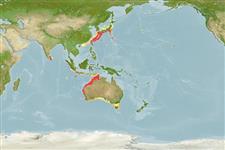Teleostei (teleosts) >
Ophidiiformes (Cusk eels) >
Ophidiidae (Cusk-eels) > Neobythitinae
Etymology: Neobythites: Greek, neos = new + Greek, bythitis, -idos = it is at the bottom, sunken (Ref. 45335).
More on author: Nielsen.
Environment: milieu / climate zone / depth range / distribution range
Ecology
Marine; bathydemersal; depth range 42 - 350 m (Ref. 88876). Deep-water
Eastern Indian Ocean: western Australia and Northwestern Pacific: Okinawa, Japan.
Size / Weight / Age
Maturity: Lm ? range ? - ? cm
Max length : 16.7 cm SL male/unsexed; (Ref. 88876)
A benthic species found on the continental shelf and slope (Ref. 75154). Reproductive strategy possibly similar to other members of this family featuring oviparity, with oval pelagic eggs floating in a gelatinous mass (Ref. 205).
Life cycle and mating behavior
Maturity | Reproduction | Spawning | Eggs | Fecundity | Larvae
Okamoto, M., J.G. Nielsen and H. Motomura, 2011. First record of the cusk-eel, Neobythites australiensis Nielsen (Ophidiiformes: Ophidiidae), from the Northern Hemisphere. Biogeography 13:69-71. (Ref. 88876)
IUCN Red List Status (Ref. 130435: Version 2024-2)
Threat to humans
Harmless
Human uses
Tools
Special reports
Download XML
Internet sources
Estimates based on models
Preferred temperature (Ref.
123201): 13.8 - 25.3, mean 20.2 °C (based on 87 cells).
Phylogenetic diversity index (Ref.
82804): PD
50 = 0.5000 [Uniqueness, from 0.5 = low to 2.0 = high].
Bayesian length-weight: a=0.01000 (0.00244 - 0.04107), b=3.04 (2.81 - 3.27), in cm total length, based on all LWR estimates for this body shape (Ref.
93245).
Trophic level (Ref.
69278): 3.5 ±0.5 se; based on size and trophs of closest relatives
Resilience (Ref.
120179): High, minimum population doubling time less than 15 months (Preliminary K or Fecundity.).
Fishing Vulnerability (Ref.
59153): Low vulnerability (10 of 100).
